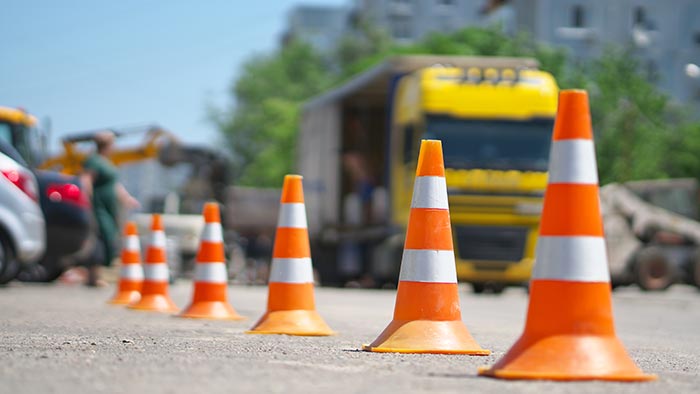Mobility reimagined for a new normal
With the emergence of COVID-19 came a brutal realisation: when people move freely within a modern transport system, virus transmission can spread rapidly.
With the exception of essential supply chains and services, the pandemic has brought much of the world to a begrudging standstill.
Although restrictions caught many unaware, the world’s leaders in transport systems, technology and infrastructure believe an assessment of what constitutes acceptable modes of travel was always inevitable. COVID-19 merely accelerates the need for innovation to create a new normal in a post-pandemic world.

With the exception of essential supply chains and services, the pandemic has brought much of the world to a begrudging standstill
Among these experts is Peter Sweatman, Enterprise Professor in Transport Technologies at the University of Melbourne.
He says transport systems were already in crisis; record congestion, health impacts from pollution, climate change and road safety, plus a decline in liveability and social equity due to disparities in access to transport.
This crisis, however, also represents an opportunity for a pause, rethink and possible reset.
New perspectives
Drawing on recent technological advances, a highly collaborative worldwide network of researchers, governments, regulatory agencies and private companies are working together to make transport more efficient, sustainable and equitable.
“While new technology also makes transport better equipped to deal with events like a pandemic, COVID-19 has taught us that we need to think more about the social aspects around transport, issues like crowding on public transport,” Professor Sweatman says.
Those considerations are being added to three core technical ingredients: data, connectivity and automation.
That means ensuring transport infrastructure has the ability to capture real-time data across a network, be it road, rail, tram, bike or footpaths. Data can then be processed in real time to create analytical and predictive modelling capacity to inform the network’s operations.
The next step is to plug control room operators and transport users into this holistic information grid to achieve new efficiencies, better meet user expectations and deal with events like a pandemic.
Another important step is to expand access to the grid data to include automated vehicles, effectively making them Connected Automated Vehicles (CAVs).
While new technology also makes transport better equipped to deal with events like a pandemic, COVID-19 has taught us that we need to think more about the social aspects around transport, issues like crowding on public transport
Carla Bailo, CEO of the Centre for Automotive Research in Michigan, says that unlike cars, people are not expected to own CAVs. The idea is to deploy CAV fleets to keep people moving smoothly. This approach has added social benefits; freeing up roads to include bike lanes, allowing for a vibrant street life and helping maintain social distancing within a driverless, private environment.
Integrated options
“A lot of the innovation hinges on using transportation more efficiently and with greater levels of coordination and connectivity,” Professor Sweatman says. “That’s achievable by integrating big data, artificial intelligence, connectivity, design solutions, automated vehicle technology and a better understanding of users’ expectations and needs.”
Impacts from this new technology are already being felt and applications have been developed for dealing with COVID-19-related restrictions. A trial is underway on the public train system in North Sydney to test the technology.
Dr Chen Cai of CSIRO’s Data61 says the project involves taking fragmented data about disparate segments of people’s journeys and joining it up to create a holistic view of demand and supply across Sydney’s public transport system.
The addition of data analytics and predictive modelling then makes it possible to move people with greater efficiency by changing how fleets are assigned across the network. The trial in North Sydney will roll out the use of this technology to allocate services and could be used as part of broader efforts to avoid crowding.
Unusual and surprising lessons are emerging from the depths of new datasets, creating excitement among industrial designers like Jeevak Badve, Director of Strategic Growth at Sundberg-Ferar.
He says a diversity of expectations, needs and desires are emerging from individual transport users. This diversity creates new opportunities to integrate transportation’s hardware, software and infrastructure in novel ways with an individualised edge.
A lot of the innovation hinges on using transportation more efficiently and with greater levels of coordination and connectivity
Underpinning the delivery of CAVs and transport solutions is the willingness of the international transport sector to collaborate and to share resources, data and limited investment dollars to make the most rapid and strategic gains.
This approach is nurtured by one of the key global research centres – the Australian Integrated Multimodal EcoSystem (AIMES) where Professor Sweatman is based. This program includes a living laboratory established by the University of Melbourne on the streets of Melbourne to develop and test intelligent transportation systems (ITS).
It’s hoped that AIMES and its many domestic and international partners will continue to find transport solutions to will drive us beyond the current crisis and well into the future.
The Michigan Australian Exchange in Mobility (MAX) is part of the AIMES collaboration. Regular webinars on important topics in the transportation revolution are held for global audiences.
Issues relating to COVID-19 and the associated transport disruption were discussed in the June webinar, ‘Pieces of the New Normal’ produced in association with ITS Australia and the Michigan Economic Development Corporation.
Related topics